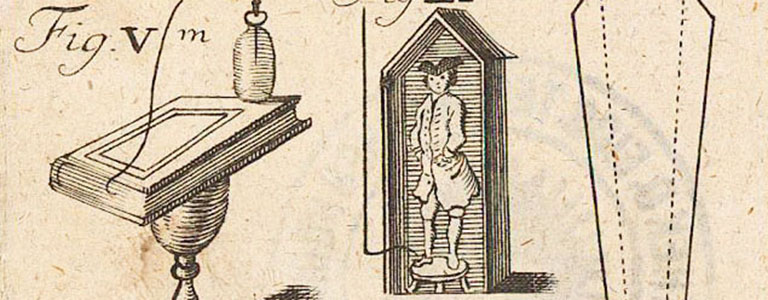Many rare books have had a long and exciting journey on their way to a safe haven in a library. These works have for example seen continuous change in ownership and travelled through many countries over the centuries. The fate of these ‘travelling books’ has often been documented: thus handwritten notes, stamps and labels have assumed the role of storyteller, in many cases leaving unsolved mysteries in their wake.
RARE BOOKS
The terror of frogs and the birth of the novel Frankenstein
Many thousands of frogs fell victim to Luigi Galvani’s scientific curiosity, and all because the anatomist observed how the leg of a dissected frog began to twitch as if from nowhere. This occurrence took place in Bologna in 1780 and led to one of the most important discourses in scientific history – and to the birth of the novel Frankenstein.
The threads of the aurora and isochasms
Few natural phenomena are as spectacular to the observer as the aurora with its arcs of light. While it was known in antiquity as band of fire, beam or opening, metaphorical expressions prevailed in the Middle Ages such as fiery lances or burning red. It is now
From the eruption of Krakatoa to Munch’s The Scream – the phenomenon known as the twilight effect
On 27 August 1883 the volcano known as Krakatoa, itself part of an island archipelago of the same name, was destroyed in an enormous explosion. The detonation’s blast is said to have been heard thousands of kilometres away, sending shock waves round the world several times.
How a dentist wrote medical history with an iron hand
When demand for prostheses increased massively in war-torn Europe at the beginning of the nineteenth century, Pierre Ballif (1775–1831), personal dentist to the King of Prussia in Berlin, developed new technology and in doing so created the basis for the further development of artificial limbs.
Travelling through Zurich on the Rösslibahn 140 years ago
The blue and white trams are as much part of the Zurich cityscape as the Grossmünster. We take for granted high frequencies between the centre and the various districts of the city. But completion of the first tram line in Zurich did in fact require several attempts.
Drawing electricity out of the clouds: Benjamin Franklin’s ‘Letters about Electricity’
‘Eripuit caelo fulmen sceptrumque tyrannis’ (He snatched the thunderbolt from heaven and the sceptre from tyrants) is an epigram about Benjamin Franklin, coined by the French economist and minister Anne-Robert Jacques Turgot (Möhring 2010, p. 253). It shows that Franklin achieved fame in the eighteenth century not only as co-author and signatory of the American Declaration of Independence but also as researcher into electricity and inventor of the lightning conductor.
Assertio 123 – Galileo Galilei recants
When the title of a book is ‘Anticopernicus catholicus’, it is not necessary to explain that its author Giorgio Polacco pits himself against the heliocentric world view and it is likewise clear that the arguments of the Roman Catholic church must be anticipated. That his own condemnation and adjuration – printed in full – also had to be used as an argument would not have pleased Galileo Galilei at all.
On the animal kingdom’s tail: Gessner’s composite sketches
Conrad Gessner (1516-1565), a polymath and Zurich city doctor, lived at a time when traditional knowledge was joined by a wealth of new experiences. Not only did the discovery of America open up unknown places, but also unfamiliar flora and fauna. At the same time, many ancient
“Be ye therefore wise as serpents, and harmless as doves” – Froben’s printer’s signet
They acted as a kind of copyright and were supposed to protect publications against unlawful reprinting by third parties: printer’s marks, also referred to as printer’s signets. They were added to books by the first publishers of printed material to label their source clearly. As there









